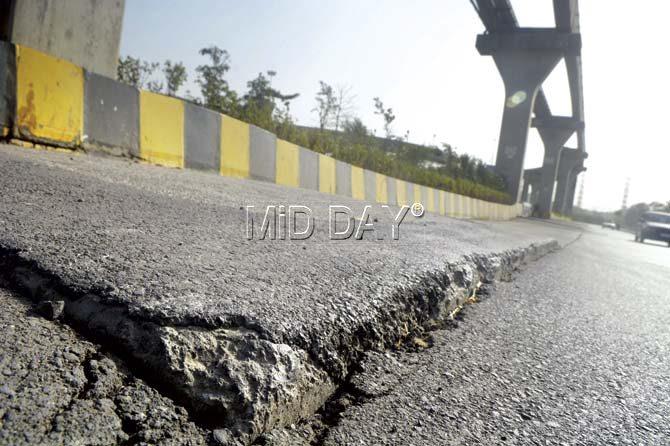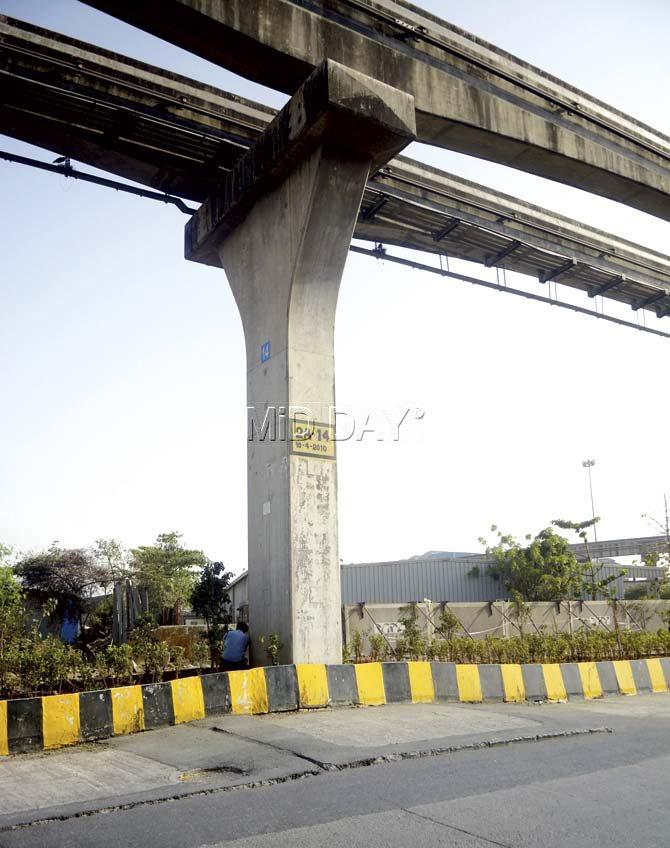Officials say that the stretch between Wadala Depot and Bhakti Park stations has been severely affected due to piling activity at a nearby site and shoddy Monorail construction work

When the city’s Monorail was thrown open to the public, the areas around the piers that support the elevated track were at the same level of the road. Motorists did not have any problems in navigating the stretch around the piers. Now the area surrounding more than 25-30 piers between Wadala Depot and Bhakti Park Monorail stations is at a higher level than the road.
ADVERTISEMENT

The cracks on the road surrounding the piers make this stretch extremely dangerous for motorists. Pics/Pradeep Dhivar
Cracks have also developed on this stretch, because of which the entire area surrounding the piers has become uneven, posing a serious threat to motorists. Requesting anonymity, an MMRDA official told mid-day that the surface might have risen due to the piling work that is taking place at a construction site near this particular Monorail stretch.

The area around the piers has risen by as much as 5 inches
The cracks on the elevated parts on this stretch are clearly visible. On Tuesday, mid-day visited the spot and found that an area of about 5-8 feet around each pier has risen and developed cracks. At some places, the portion is more than 5 inches above the road surface, because of which it becomes difficult for motorists (two-wheelers are at a greater risk) to navigate this stretch.
Requesting anonymity, MMRDA officials blame the quality of Monorail construction and the piling work that is taking place in the nearby construction site for the situation. Furthermore, these officials say that the problem will be severely accentuated during the monsoon, as rainwater would not be able to seep through to the ground.
This area is also notorious for streetlights that are perpetually on the blink. PRK Murthy, chief of transport and communication Department, MMRDA, told mid-day, “The construction of the Wadala-Anik Road and Sion–Koliwada road has been done via the stone column method.
This is also known as a geo-grid system, as the construction has to be done on marshy land. The work was done by BMC and the procedure was approved by IIT Bombay.” Murthy says that the problem might have arisen due to the impact of the previous monsoon, since rainwater could not percolate to the water table.
“The Monorail has come up and has disturbed the geo-grid in the area. The area surrounding the pier appears bloated. Water did not percolate to the ground and the capillary action around the piers pushed the area surrounding the piers upwards.
But it is not dangerous for the Monorail piers; they are completely safe and the examination of the same has been done in the past,” added Murthy. According to MMRDA officials, a VJTI (Veermata Jijabai Technological Institute) expert committee has also submitted a report in this regard.
“VJTI has already submitted its report and as a third-party safety check, we have asked the Central Road Research Institute (CRRI) to also look into the issue and suggest measures for improving the situation.
We are yet to receive the final report, but some of the findings from the report say that the reason behind the bloating of surface around the Monorail pillar may be because of the piling activity that is taking place near a construction site that is a few meters away from the Monorail piers. Rainwater has also not been able to percolate and reach the groundwater table,” said an MMRDA official.
 Subscribe today by clicking the link and stay updated with the latest news!" Click here!
Subscribe today by clicking the link and stay updated with the latest news!" Click here!






